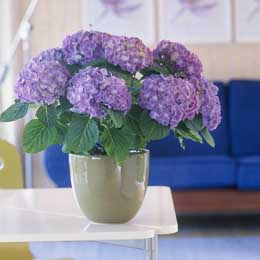 |
Hydrangea
Name - The name says it all - it needs plenty of water. Hydor (Greek)
means water, angos a jar or vessel (because the fruit is cup shaped). Most of
the pot grown ones are Hydrangea (pronounced hiy-DRANE-gee-a) macrophylla, in
the past mainly the variety "Hortensia", which they are occasionally
called. Macrophylla means large leaved.
Description - They are
low-growing shrubs with short woody stems with largish leaves and large round,
impressive flower heads. Some varieties are lace-cap types, some huge pompoms.
Family - Hydrangeaceae
Origin - Japan, introduced to
the UK in 1788.
Colour - Different shades of blue, pink and white.
The colour is affected by the acidity level of the soil - blue or purple in acid
and neutral soils, pink or purple/red in alkaline mixtures.
Family
- Saxifragaceae (saxifrage family)
Care Tips - It likes bright
light but not full sun and loves a spell outside in the shade in summer. In winter
it will lose its leaves so hide in a dark spot and bring out again in early spring
or plant it outside after flowering. Water plentifully to keep the compost thoroughly
moist and feed every two weeks in the growing period with rhododendron fertiliser
or similar. Never let it dry out, but if it does, stand the pot in a bucket of
water till it revives. Even if the treatment works, the current flowering period
will be shortened.
Trivia - History: The first lace-cap
hydrangeas to be discovered by a Westerner were H mariesii and H. veitchii by
Charlies Maries while searching in Japan. He later worked in India where he was
superintendent of the Maharajas of Gwalior's gardens.
>> Click
here for Hydrangea Flower Facts
>> Click
here for Hydrangeas - Inner Beauty

back |
|
|

